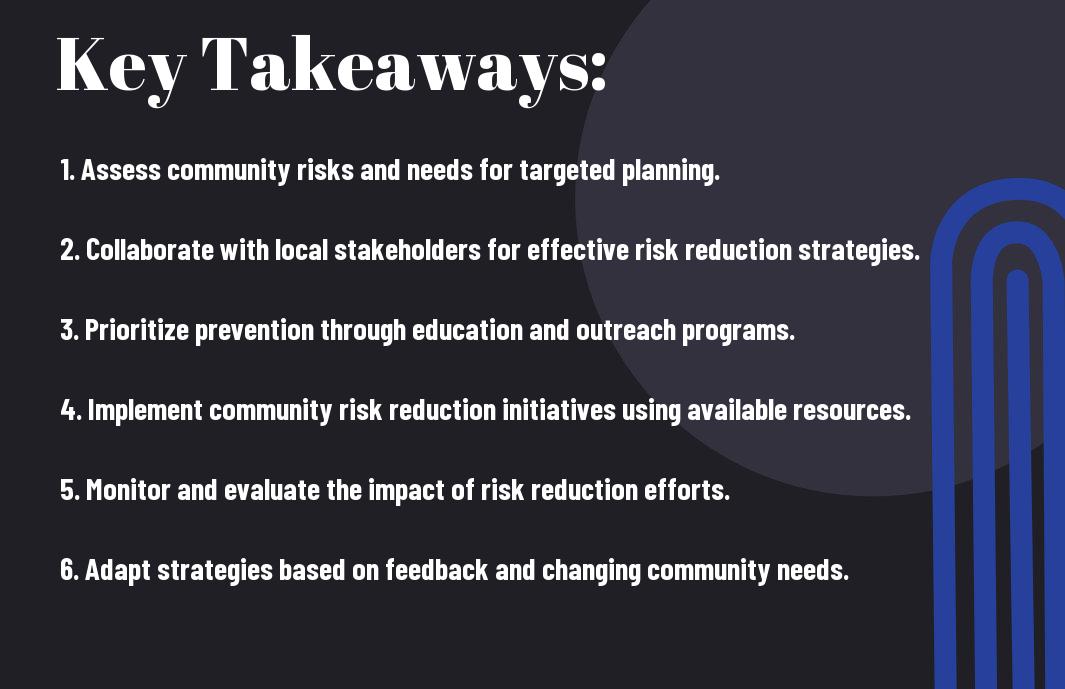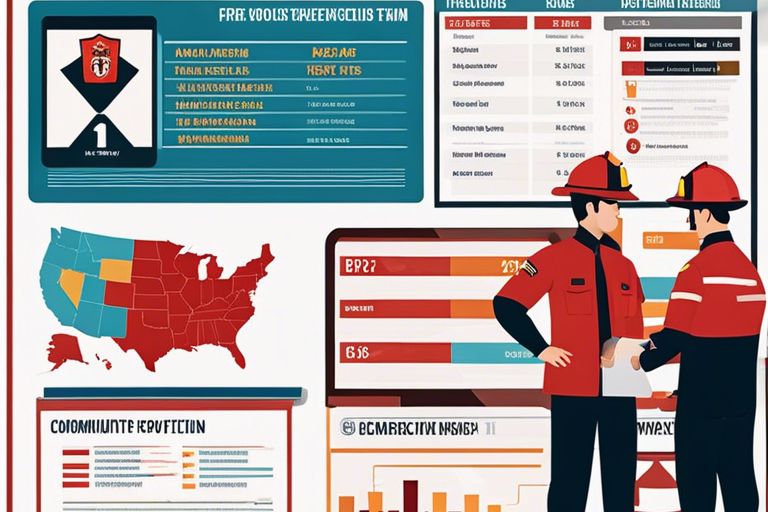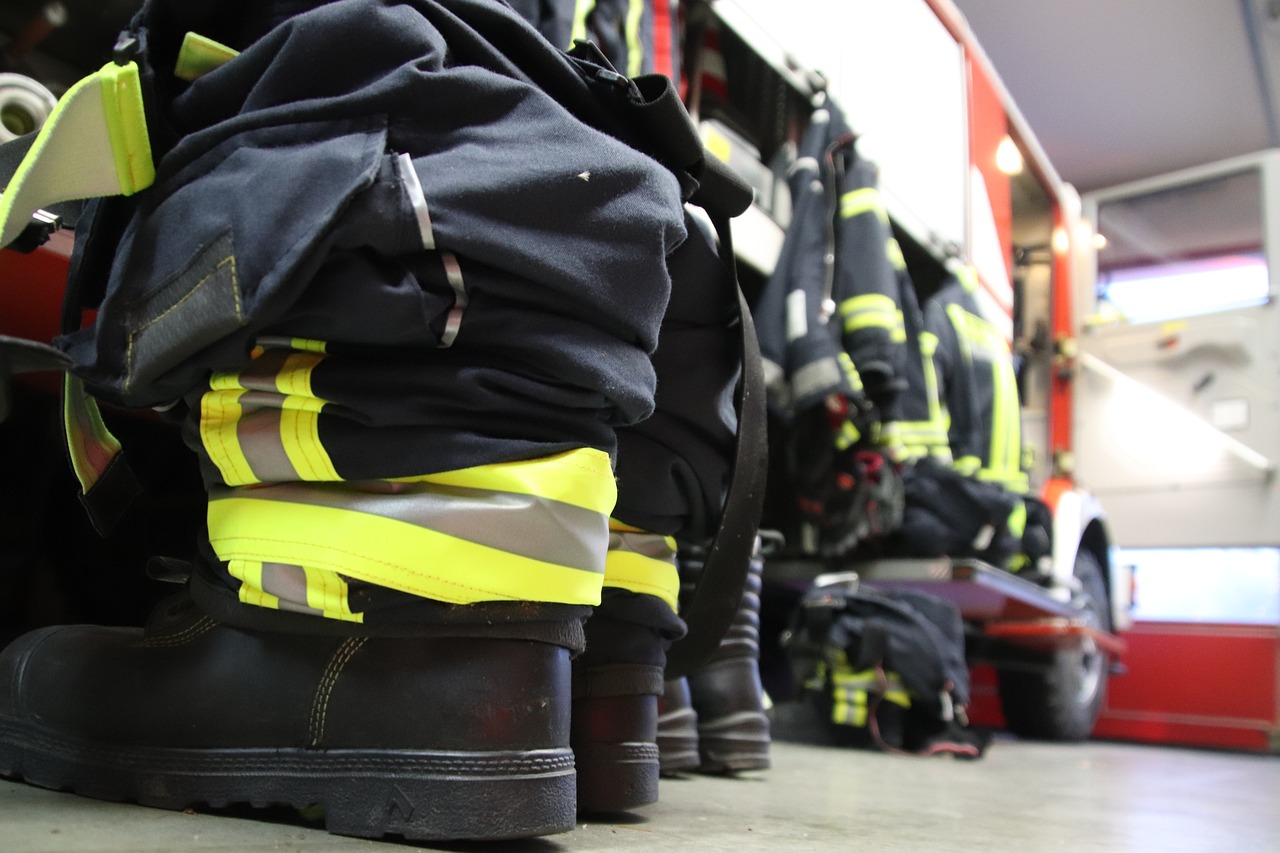Efforts to minimize community risks are crucial for your volunteer fire department’s success. By following these five practical steps, you can significantly enhance your community risk reduction efforts. From conducting thorough risk assessments to educating the public, these proven strategies will empower you to make a positive impact on community safety. Let’s examine how you can enhance your volunteer fire department’s community risk reduction efforts effectively and efficiently.
Identify Your Community’s Risk Profile
To enhance your community risk reduction efforts for your volunteer fire department, it is crucial to identify and understand your community’s specific risk profile. By doing so, you can tailor your strategies and resources effectively to address the most pressing issues and vulnerabilities.
Assessing Demographics and Socioeconomic Factors
An important first step in identifying your community’s risk profile is assessing the demographics and socioeconomic factors that could influence the level of risk present. Look into factors such as population density, age demographics, income levels, and ethnic diversity to gain insight into the unique challenges your community may face in terms of fire emergencies. Understanding these underlying factors can help you better target your prevention and response efforts to effectively reach and serve all members of your community.
- Population density
- Age demographics
- Income levels
- Ethnic diversity
Knowing these details will enable you to create targeted outreach programs and initiatives that address the specific needs of different segments within your community.
Analyzing Local Hazards and Emergency Response History
Emergency response history and local hazard analysis are crucial components of understanding your community’s risk profile. By analyzing past incidents and response times, you can pinpoint recurring issues and vulnerabilities that need to be addressed. Moreover, by assessing the frequency and severity of various hazards such as wildfires, floods, or industrial accidents, you can prioritize your prevention and preparedness efforts to mitigate the most significant risks.
Analyzing the local hazards and emergency response history will help you identify the most critical areas for improvement in your community’s emergency preparedness and response capabilities. This information allows you to allocate resources efficiently and implement targeted training programs to enhance your department’s effectiveness in mitigating risks and protecting community members.
Develop a Comprehensive Risk Reduction Plan
Assuming you want to enhance your community risk reduction efforts, it is crucial to develop a comprehensive plan that outlines your strategies and objectives clearly. To create an effective plan, it’s vital to understand the components of Community Risk Reduction (CRR). Consider exploring the Components of CRR: The 5 E’s of Community Risk Reduction, which include Education, Enforcement, Engineering, Economic Incentives, and Emergency Response. Incorporating these elements into your plan will help you address various aspects of risk within your community.
Setting Clear Goals and Objectives
Develop specific and measurable goals that align with your department’s mission and vision. Your objectives should be realistic and achievable, allowing you to track progress effectively. By defining clear goals, you can focus your efforts on areas that require attention and demonstrate the impact of your risk reduction initiatives.
Identifying Key Stakeholders and Partnerships
To enhance your risk reduction plan, establish strong partnerships with key stakeholders in your community. These partnerships can include local businesses, government agencies, schools, healthcare providers, and community organizations. By collaborating with these stakeholders, you can access additional resources, expertise, and support to strengthen your risk reduction efforts.
It is crucial to involve a wide range of stakeholders in your risk reduction plan to ensure a holistic and inclusive approach. Engaging with various partners will enable you to leverage different perspectives, resources, and networks to address community risks effectively.
Allocating Resources and Budget
Partnerships with local businesses, government agencies, and community organizations can provide valuable resources and funding to support your risk reduction initiatives. By leveraging these partnerships, you can access additional manpower, equipment, and financial support that are vital for implementing your plan effectively.
Another important aspect of allocating resources is ensuring that your budget aligns with your goals and objectives. Make sure to prioritize areas that require immediate attention and allocate resources accordingly to maximize the impact of your risk reduction efforts.
Implement Proactive Risk Reduction Strategies
Unlike reactive measures that are taken after an incident occurs, proactive risk reduction strategies focus on preventing emergencies from happening in the first place. By implementing proactive measures, you can significantly reduce the risks faced by your community and enhance the overall safety and well-being of its residents. Here are some key steps you can take to enhance your community risk reduction efforts.
Conducting Public Education and Awareness Campaigns
Campaigns aimed at educating the public about fire safety and prevention are crucial in reducing the risk of fires. By organizing workshops, distributing informational materials, and utilizing social media platforms, you can raise awareness about fire hazards and the importance of taking preventive measures. Empowering community members with knowledge and information can help them make informed decisions that contribute to a safer environment for everyone.
Providing Fire Safety Inspections and Code Enforcement
Public safety inspections and enforcement of fire codes are important components of proactive risk reduction. By conducting regular inspections of commercial and residential properties, you can identify potential fire hazards and ensure compliance with safety regulations. This proactive approach not only reduces the risk of fires but also helps to prevent injuries and save lives.
Education: Fire safety inspections involve assessing buildings for potential hazards such as faulty wiring, blocked exits, and flammable materials. By addressing these issues promptly, you can mitigate the risk of fires and improve overall safety standards in your community.
Collaborating with Local Businesses and Organizations
Organizations: Establishing partnerships with local businesses and organizations can enhance your community risk reduction efforts. By working together, you can coordinate fire safety training sessions, emergency drills, and evacuation procedures. Collaborating with stakeholders in your community allows you to pool resources and expertise, making your risk reduction strategies more effective and sustainable.
Providing ongoing support and guidance to local businesses and organizations can help ensure that they are equipped to handle emergencies effectively. By fostering strong relationships and communication channels, you can create a network of support that enhances the overall safety of your community.
Leverage Technology and Data to Enhance Risk Reduction
For your volunteer fire department to enhance community risk reduction efforts, leveraging technology and data can be a game-changer. By utilizing Geographic Information System (GIS) mapping and spatial analysis, you can identify high-risk areas in your community, pinpoint locations with a high incidence of fire incidents, and strategically allocate resources for prevention and response.
Utilizing GIS Mapping and Spatial Analysis
Utilizing GIS mapping and spatial analysis allows you to visualize data in a geospatial context, providing valuable insights into where risks are concentrated. By overlaying data on factors such as demographics, infrastructure, and historical incident reports, you can create heat maps and predictive models to proactively address potential hazards.
Implementing Fire Incident Reporting and Analysis Systems
Fire incident reporting and analysis systems are powerful tools that can streamline data collection, analysis, and reporting processes. By implementing a system tailored to your department’s needs, you can track incident trends, identify recurring causes of fires, and measure the effectiveness of your prevention efforts. This data-driven approach enables you to make informed decisions and continuously improve your risk reduction strategies.
Reporting: Implementing fire incident reporting and analysis systems provides you with real-time data and analytics to enhance your department’s situational awareness and response capabilities. By capturing detailed information about incidents, response times, and outcomes, you can identify areas for improvement, allocate resources more efficiently, and ultimately save lives.
Leveraging Social Media and Emergency Alert Systems
An integral part of enhancing community risk reduction efforts is leveraging social media platforms and emergency alert systems to disseminate vital information quickly and efficiently. By utilizing these communication channels, you can educate the public about fire prevention measures, promote community engagement, and alert residents about potential risks or emergencies in real-time.
Media: Leveraging social media and emergency alert systems enables you to reach a broader audience and engage with community members proactively. By sharing safety tips, updates on incidents, and emergency notifications through these platforms, you can foster a culture of preparedness and collaboration within your community.
Engage and Empower Your Community
After Community Risk Reduction (CRR) Leading the Way to … efforts and identifying key risks in your community, the next step is to engage and empower your community in fire prevention and safety measures. Building partnerships with local schools and community groups is crucial in spreading awareness and educating residents on fire risks and prevention strategies.
Building Partnerships with Local Schools and Community Groups
Your volunteer fire department can collaborate with schools to implement fire safety education programs for students. By conducting fire drills, workshops, and demonstrations, you can instill valuable knowledge about fire prevention in the younger generation. Additionally, reaching out to community groups such as neighborhood associations or local clubs can help amplify your message and engage a broader audience in fire safety initiatives.
Organizing Community Events and Outreach Programs
Programs that involve the community in fire safety activities can significantly enhance your department’s outreach efforts. Hosting events like open houses, safety fairs, or hands-on training sessions can attract residents of all ages and backgrounds. By offering interactive experiences and educational materials, you can effectively communicate important fire safety practices to the community.
Plus, creating partnerships with local businesses or organizations to sponsor these events can help increase participation and support for your initiatives.
Fostering a Culture of Fire Safety and Prevention
Prevention is key to reducing fire-related risks in your community. By fostering a culture of fire safety and prevention, you can empower residents to take proactive steps in safeguarding their homes and families. Implementing regular fire safety campaigns, sharing tips through social media channels, and distributing educational materials are effective ways to keep fire prevention top of mind for community members.
To further strengthen your community’s commitment to fire safety, consider organizing contests or challenges that promote best fire safety practices. By incentivizing participation and rewarding adherence to safety guidelines, you can create a sense of collective responsibility towards fire prevention within your community.
Monitor and Evaluate Progress
Despite your best efforts in implementing community risk reduction programs, it is vital to monitor and evaluate progress regularly. By doing so, you can ensure that your volunteer fire department’s efforts are effective and making a positive impact on the community.
Establishing Performance Metrics and Benchmarks
An vital step in monitoring progress is establishing performance metrics and benchmarks. These metrics can include the number of community outreach events conducted, the percentage of homes with updated smoke detectors, or the response time to emergency calls. By setting specific benchmarks, you can track your department’s progress and identify areas that may need improvement.
Conducting Regular Risk Reduction Program Evaluations
Evaluate the effectiveness of your risk reduction programs by conducting regular evaluations. It is important to assess whether the programs are meeting their intended goals and if there are any gaps that need to be addressed. **It** is recommended to gather feedback from community members, partner organizations, and department members to gain a comprehensive understanding of the program’s impact.
It is vital to analyze data and feedback collected during evaluations to identify areas for improvement and adaptation in your risk reduction efforts. By pinpointing strengths and weaknesses in your programs, you can make informed decisions on how to enhance their effectiveness and better serve the community.
Identifying Areas for Improvement and Adaptation
Reduction of fire risks in the community requires continuous improvement and adaptation of your strategies. **For instance**, if evaluations reveal that a particular outreach program is not reaching the intended audience effectively, you may need to adjust your communication methods or target different demographics. **Identifying** areas for improvement allows your department to evolve and tailor its risk reduction efforts to better meet the needs of the community.
For instance, if evaluation reveals that a certain demographic group is not adequately represented in your outreach programs, you may need to explore new channels of communication or partnerships to reach them effectively. This continuous process of identifying areas for improvement and adaptation will help your volunteer fire department stay proactive and responsive in its community risk reduction efforts.

Final Words
As a reminder, enhancing community risk reduction efforts for your volunteer fire department is a proactive step towards better protecting your community. By following the five steps outlined in this article, you can make a significant impact in reducing the risks faced by your community members. Do not forget, it all starts with evaluating your community’s needs, communicating effectively, collaborating with other stakeholders, implementing initiatives, and continuously evaluating and adjusting your efforts to ensure effectiveness.
By taking these steps, you are not only improving the safety and well-being of those you serve but also strengthening the bonds within your community. Your dedication and commitment to enhancing community risk reduction efforts are crucial in making a positive difference. Keep up the great work, and always remember the importance of community involvement and collaboration in achieving your goals.



